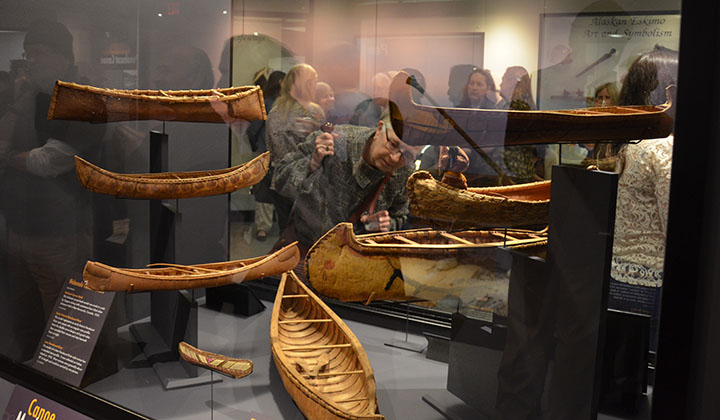Native American birchbark canoes have often been described as one of the greatest inventions in human history and were copied by Euroamerican fur traders and sportsmen. Since the 17th century, the evolution of these traditional canoes has been propelled by both Indians and non-Indians. The Legacy of Penobscot Canoes: A View from the River reveals the enduring importance of rivers and canoes in Penobscot tribal life and the relationships between the tribe and non-Indians. This new installation features a rarely seen full-size bark canoe purchased from Penobscot Indian Francis Sebattis in 1912.
Peabody Museum co-curators Castle McLaughlin and Patricia Capone consulted with Steve Cayard, a master builder of traditional birchbark canoes, to share the history and construction of the watercraft. They created a multifaceted picture of the Penobscot’s close ties to the river as log drivers, craftsmen, trappers, guides, present-day stewards, and environmental stakeholders. With miniature canoe models and video of traditional canoe construction, the exhibition explores both the preservation of canoe culture and its current revival among the Wabanaki people, including the Penobscot. The exhibition also includes early stone tools owned by Henry David Thoreau, who described the Penobscot and their canoes in The Maine Woods.

The Legacy of Penobscot Canoes: A View from the River opens to the public Saturday, April 12 at 9:00 AM at Harvard University’s Peabody Museum of Archaeology & Ethnology at 11 Divinity Avenue, Cambridge, Mass. It will remain on view through April 30, 2016.
See the related exhibition at the adjacent Harvard Museum of Natural History, Thoreau’s Maine Woods: A Journey in Photographs with Scot Miller, running through September 1, 2014.) Admission to the Peabody Museum includes admission to the Harvard Museum of Natural History.
For more information: www.peabody.harvard.edu/exhibitions
——Press Release



